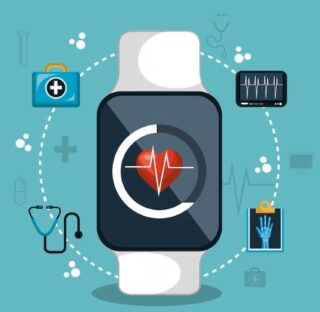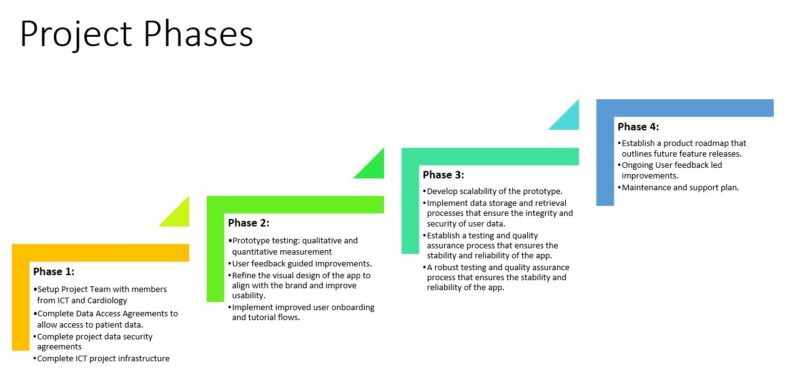Q Exchange
QRS CARDIOLOGY: Improving patient access by streamlining cardiology workflows
- Proposal
- 2023

Meet the team
Also:
- Dr David McEneaney, Cardiologist (Project Lead), Natalie Archer, Cardiac Physiologist, Alicja Jasinska-Piadlo, Cardiology Specialist Trainee. DrAisling Diamond, Deputy Medical Director For Education and Workforce.
What is the challenge your project is going to address and how does it connect to the theme of 'How can improvement be used to reduce delays accessing health and care services'?
Large DGHs perform around 15,000 investigations every year (excluding ECGs). As part of the patient journey in cardiology, patients often have multiple investigations requested.
- Waiting times for investigations vary and duplicate investigations may be requested.
- Patients may be admitted to other hospitals and have investigations performed.
- The waiting lists for cardiac investigations may reside on multiple different databases, and indeed in different healthcare facilities.
- This leads to duplication of investigations and patients remain unnecessarily on wating lists.
Our DGH cardiology service has been able to reduce waiting lists by up to 20% by manual chart review and accessing the electronic care record, removing duplicate or completed investigations from the waiting lists.
However
- chart review is time consuming
- utilises precious medical and nursing staff time and,
- the process is a temporary measure, requiring repeat validation every few months.
What does your project aim to achieve?
A data analytic product will be used to consolidate waiting list data across a number of cardiovascular and radiology databases in the cardiac investigations department and nuclear medicine.
We have already developed a prototype online platform for requesting cardiology investigations using a web interface:
https://cardio.h9-healthcare.com/login
Username “Test”
Password “Test”
Our next phase will create a data analytic platform to consolidate waiting list data across multiple cardiology and radiology databases.
At present waiting lists, scheduling plans and results reside on different databases in different departments.
If a patient has equivalent investigations requested the platform will automatically highlight this and rationalise that patient’s investigation journey.
This will eliminate duplicate investigations and investigations that provide equivalent information. This will:
– Eliminate duplicate and equivalent requests, saving time and resources
– Reduce waiting times and improve patient access
A Data Protection Impact Assessment (DPIA) has been completed. No patient identifiable information will be accessed or processed.
How will the project be delivered?
 This project will be implemented in 4 phases
This project will be implemented in 4 phases
Phase 1:
- Setup Project Team with members from ICT and Cardiology
- Complete Data Access Agreements to allow access to patient data.
- Complete project data security agreements
- Complete ICT project infrastructure
Phase 2:
- Prototype testing: qualitative and quantitative measurement
- User feedback guided improvements.
- Refine the visual design of the app to align with the brand and improve usability.
- Implement improved user onboarding and tutorial flows.
Phase 3:
- Develop scalability of the prototype.
- Implement data storage and retrieval processes that ensure the integrity and security of user data.
- Establish a testing and quality assurance process that ensures the stability and reliability of the app.
- A robust testing and quality assurance process that ensures the stability and reliability of the app.
Phase 4:
- Establish a product roadmap that outlines future feature releases.
- Ongoing User feedback led improvements.
- Maintenance and support plan.
How is your project going to share learning?
· Documentation: Sharing the valuable project development learning for others who are working on similar projects or who want to learn more about the project through the Q Community.
· Blog posts and articles: These can be published on the project website or shared on social media platforms to reach a wider audience.
· Commercialisation: If the project is successful then there would be opportunity to commercialise this service and offer it for sale to other Q members at discounted prices or to the wider healthcare market.
· Presentations and talks: Conferences, meetups, or other events to share their learning and insights with a broader audience.
· Online courses and tutorials: The team could create online courses or tutorials that teach others how to use it.
How you can contribute
- - We welcome input from any experts willing to share their experiences, both positive and negative, when developing app based technology to impact diagnostic waiting list management.
Plan timeline
| 31 Mar 2023 | Setup Project Team: Detailed planning and output measures agreed. |
|---|---|
| 30 Jun 2023 | Complete Phase 1: Data Access and Security Agreements. |
| 16 Jul 2023 | Phase 2: Prototype testing. Qualitative and Quantitative measurement. |
| 16 Aug 2023 | Phase 2: User feedback guided improvements, user onboarding and tutorial flows. |
| 1 Sep 2023 | Phase 3: Develop scalability of the prototype. |
| 2 Oct 2023 | Phase 3: Testing and Quality Assurance - stability, reliability and user feedback. |
| 1 Nov 2023 | Phase 3: Trust wide App implementation. |
| 1 Dec 2023 | Phase 3 Review. |
| 19 Jan 2024 | Phase 4: Establish product roadmap outlining future feature releases. |
| 8 Feb 2024 | Phase 4: Maintenance and ongoing evaluation. |